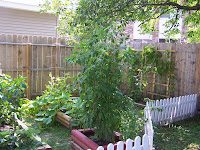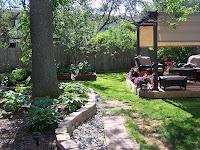I happened to find a blog through the round-about-searching on websites that have links to other sites (gotta love the www). This little blog was called the Pen Pal Project. Two women, 1000 miles apart who apparently exchange tidbits about their lives, their love of cooking and their love of their families. It's called "Summerharms." There on the blog, was an entry on 8 September 2010 that caught my eye. It said "rescue a dairy farm , (go here), because of the economic downturn last year - they are in danger of losing their farm. It got me thinking. The fact that I had randomly come across stories just like this on the radio, in magazines and in local newspapers I decided that I would do something different. I would take part in this thing that I had heard of which was called "slow money."
Over the past year I have seen several articles discussing the idea of 'slow growth' and how vital it is for America to reinvest in itself in order to move forward. 'Slow growth' involves investing in local business, local economy and local people. Several years ago in California and some of the eastern agriculture states asked people to invest in the small farms by buying into a plan in which money was given to the farmer, the dairyman, the small livestock owners and these owners would put that money right back into the farm. They would use it to pay their bills, the feed bills, feeding their families, paying the banker, repairing and replacing equipment and growing whatever it was that they grew. In return, the investor would receive their 'dividend' in the form of bags of fresh produce, cheese, fruit, whatever the by-product of farming produced. The farmer was able to sell, in advance, to the public without the cost of the middleman and stretch the dollar so much further than would have been possible. The 'slow growth' meant that there was money going from the farmer to the community in which he lived and did business. The seed and feed, the tractor repair person, the grocery store where he bought his own groceries that he did not grow himself/herself. The amount of people that are benefiting from this slow growth is becoming larger and larger.
Here in Michigan, when I have to go to Detroit for an appointment at the Veterans Hospital - a trip that is 119 miles round trip - I have noticed that with the demolition of abandoned houses I am seeing public gardens. And these gardens are looking glorious. There are vegetables and flowers growing and a lot of someones are coming in to tend, to care for and ultimately to consume the bounty growing there. I would be so glad to see this same idea moving into the elementary schools and middle schools. It would not be a bad thing to see something a little larger scale going on in high schools. Think of it, fruit orchards, small ones in which the fruit is grown organically. Food that can then be taken into the schools and students would learn how to prepare those foods. To see something grow and then to see it turn into nourishment for those who would otherwise never know where the food they eat comes from.
Economic growth and individual growth - the growth of the middle class and lower class into a state of grace of self-sufficiency. We don't all need to have victory gardens, maybe we should think on a larger scale. The monies that are needed to keep schools open can be stretched further by lessening the cost of food for cafeteria lunches. Why send money out to the vendors of junk food and processed foods frozen and microwavable when each student can contribute a part of themselves to their school. When we invest in ourselves, when we invest in our families, when we invest in children who cannot change the poverty that makes them more hungry for food than for knowledge - we change our world. The status quo has been shattered. We CAN make a change!



I have a small yard and when I bought my house five years ago I decided that I would like to have fruit trees instead of decorative trees that changed colors and were more landscape than food scape. I had never done this before and my partner and I followed the instructions on how to plant and the arborist told us the most important thing is 'slow watering' - for the first three years be sure to water the trees 'deep' that would mean the water would be little more than a small stream coming out and soaking into the roots for an hour or so a at least once a week. We did that and although only two of the trees are producing and the squirrels have taken over the plum tree - we have peaches this year. Lots and lots of peaches this year. And this means that my neighbors have peaches this year. If you have not tasted a fresh, sweet, dripping down your arm peach lately all I can say is this. Invest in a tree, slow water, slow growth and when the summer winds down and the sun shifts in the sky telling you that autumn is just around the corner . . . . sit down and pick the fruit and slowly savor what a little bit of labor, adequate water, and patience rewards you with magnificance!
Over the past year I have seen several articles discussing the idea of 'slow growth' and how vital it is for America to reinvest in itself in order to move forward. 'Slow growth' involves investing in local business, local economy and local people. Several years ago in California and some of the eastern agriculture states asked people to invest in the small farms by buying into a plan in which money was given to the farmer, the dairyman, the small livestock owners and these owners would put that money right back into the farm. They would use it to pay their bills, the feed bills, feeding their families, paying the banker, repairing and replacing equipment and growing whatever it was that they grew. In return, the investor would receive their 'dividend' in the form of bags of fresh produce, cheese, fruit, whatever the by-product of farming produced. The farmer was able to sell, in advance, to the public without the cost of the middleman and stretch the dollar so much further than would have been possible. The 'slow growth' meant that there was money going from the farmer to the community in which he lived and did business. The seed and feed, the tractor repair person, the grocery store where he bought his own groceries that he did not grow himself/herself. The amount of people that are benefiting from this slow growth is becoming larger and larger.
Here in Michigan, when I have to go to Detroit for an appointment at the Veterans Hospital - a trip that is 119 miles round trip - I have noticed that with the demolition of abandoned houses I am seeing public gardens. And these gardens are looking glorious. There are vegetables and flowers growing and a lot of someones are coming in to tend, to care for and ultimately to consume the bounty growing there. I would be so glad to see this same idea moving into the elementary schools and middle schools. It would not be a bad thing to see something a little larger scale going on in high schools. Think of it, fruit orchards, small ones in which the fruit is grown organically. Food that can then be taken into the schools and students would learn how to prepare those foods. To see something grow and then to see it turn into nourishment for those who would otherwise never know where the food they eat comes from.
Economic growth and individual growth - the growth of the middle class and lower class into a state of grace of self-sufficiency. We don't all need to have victory gardens, maybe we should think on a larger scale. The monies that are needed to keep schools open can be stretched further by lessening the cost of food for cafeteria lunches. Why send money out to the vendors of junk food and processed foods frozen and microwavable when each student can contribute a part of themselves to their school. When we invest in ourselves, when we invest in our families, when we invest in children who cannot change the poverty that makes them more hungry for food than for knowledge - we change our world. The status quo has been shattered. We CAN make a change!



I have a small yard and when I bought my house five years ago I decided that I would like to have fruit trees instead of decorative trees that changed colors and were more landscape than food scape. I had never done this before and my partner and I followed the instructions on how to plant and the arborist told us the most important thing is 'slow watering' - for the first three years be sure to water the trees 'deep' that would mean the water would be little more than a small stream coming out and soaking into the roots for an hour or so a at least once a week. We did that and although only two of the trees are producing and the squirrels have taken over the plum tree - we have peaches this year. Lots and lots of peaches this year. And this means that my neighbors have peaches this year. If you have not tasted a fresh, sweet, dripping down your arm peach lately all I can say is this. Invest in a tree, slow water, slow growth and when the summer winds down and the sun shifts in the sky telling you that autumn is just around the corner . . . . sit down and pick the fruit and slowly savor what a little bit of labor, adequate water, and patience rewards you with magnificance!




Comments